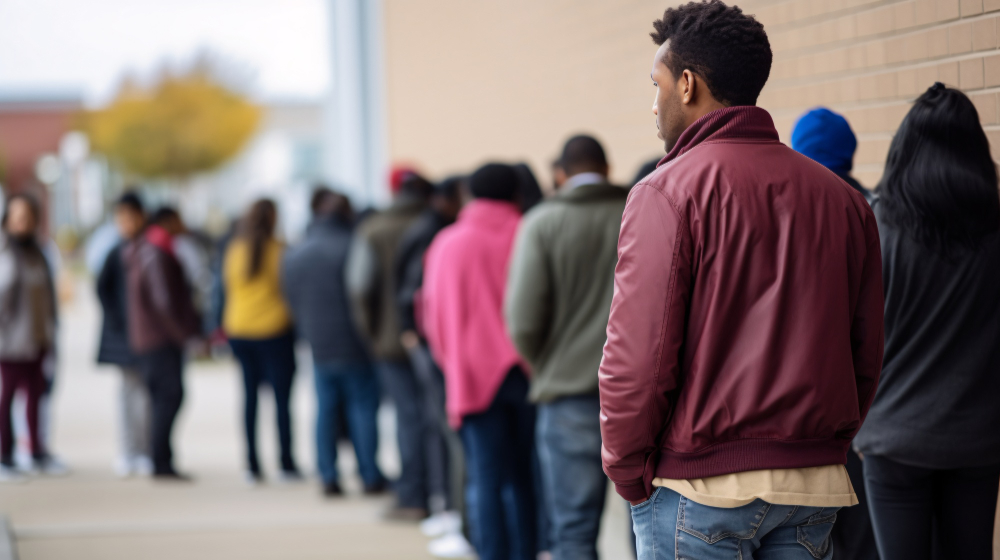- 14 3402-5578
- Rua Hygino Muzy Filho, 737, MARÍLIA - SP
- contato@latinoobservatory.org
With approximately more than 13 million inhabitants, the cities of Los Angeles, Miami and New York represent a considerable portion of the United States population. Historically standing out in internal and external scenarios, these urban centers dictate cultures, rules and policies that spread and are adopted by other cities, denoting enormous regional and international influence. Regarding this point, immigration stands out, a hallmark of these regions and which defines a high degree of attraction of these cities for individuals around the world, especially those from Latin America. To give you an idea, New York is known for its demographic and linguistic diversity, as more than 200 languages can be found in the city, with emphasis on Spanish. In 2015, nearly two million people spoke the Latin language in the city, representing more than 50% of the population at the time.
Furthermore, returning to the point of the Hispanic population, these three cities stand out in the country because they have several Latino groups that chose them to reside. It is possible to find several groups from the most varied countries in Latin America, such as Venezuela, Colombia, Chile, Peru, Brazil and others, but three can be seen with historical importance for the cities: Cubans, Mexicans and Puerto Ricans. Miami stands out for a large population of immigrants and Cuban descendants, the same with Los Angeles and Mexicans and New York with Puerto Ricans.
For historical, political and economic reasons, these groups headed to these large centers seeking greater life opportunities, an action that had a strong impact on these cities. Nowadays, none of these cities would be the same without these groups, considering that their economies and policies have changed, in addition to cultural and linguistic enrichment that would give an even richer identity to these metropolises. Therefore, it is important to analyze the history and development of the relationship between these three Latino groups and their respective cities, Los Angeles, Miami and New York.
New York and the Puerto Ricans
Historically, New York City received a large number of Puerto Ricans who chose the American urban giant as a place to seek opportunities. In 2022, about 1.1 million Puerto Ricans lived in the city's metropolitan region, one of the largest groups of Latino origin. In fact, it is a considerable number, built through years of immigration and consolidation of this community in New York, which began before the 20th century.
In the 19th century, a large wave of people from Puerto Rico started arriving in New York, even before the territory was incorporated into the United States following the war against Spain, this being the first wave of immigration to the city. A few years later after the conflict, the island of Puerto Rico, already part of the USA, received the application of the Jones-Shafroth Act of 1917, guaranteeing free access for Puerto Ricans to the country without the need for a passport. This legal change, combined with the environmental and economic crises that Puerto Rico was going through at the time, culminated in New York being viewed as a place with better opportunities for thousands of people than the island, intensifying another wave of migration. However, many ended up facing discrimination and work barriers when they arrived in the city, generating strong social exclusions.
Even so, these problems were unable to give new meaning to the idea of change that New York brought to Puerto Ricans, with the third and largest wave of immigration taking place in the 1950s, called “the Great Migration”. At that time, in the context of the Second World War, the prolonged effects of the Great Depression and the advent of aviation intensified the arrival of Puerto Ricans, who began to build a local identity. The Nuyorican, that is, the name of this migrant population or those with Puerto Rican descent, began to build their identity within New York, centralizing themselves in some neighborhoods, such as East Harlem (Spanish Harlem) and East Village (Loisaida).
In fact, immigration marked Puerto Rican culture and demographics in the city. In 1970, 70% of Hispanics residing in New York had origins or descendants from Puerto Rico, a significant number, being that year was the peak of Puerto Ricans in the city, a number that approached 900 thousand. However, the local population began to decline steadily in the following years, due to several factors, such as the immigration of Puerto Ricans to other states and the diversification of Hispanics residing in New York, who began to come from other places in America. Latin America, such as Central America, the Caribbean and SouthAmerica. To give you an idea, between 2017 and 2022, the Puerto Rican population fell from 715 thousand to 574 thousand, representing a drop of 20% and denoting a constant decrease.
However, even with a small population, the cultural and political importance of Puerto Ricans to New York is undeniable. To give you an idea, there is an entire Puerto Rican cultural movement in the city, the so-called Nuyorican Movement, a name created by mixing “New York” with “Puerto Rican”. This movement was responsible for the production of art, literature, poetry and music for years, with great names such as Miguel Algarín Jr, Esmeralda Santiago, Pedro Pietri, Tito Puente and several otherartists. Furthermore, it is not right to stop talking about great cinema classics that portrayed the relations between Puerto Rican communities and the rest of New York, such as the play and, later, film, West Side Story from 1957.
Currently, this group of Puerto Ricans can be considered consolidated in New York. Its culture and political needs are spread throughout the city, denoting its influence. If we consider the current demographics of New York neighborhoods, the Bronx, located north of the city, is where most Puerto Ricans currently live and events take place to celebrate this population, such as the National Puerto Rican Day Parade, which will take place in the city on June 9th this year. Therefore, Puerto Ricans in New York were one of the first Latino populations to consolidate themselves in a large American city, whose large presence manages to project itself nationally, both in culture and in politics, being an example of notable presences such as congresswoman Alexandria Ocasio Cortez, of Puerto Rican descent.
Los Angeles and the Mexicans
According to estimates from the 2020 and 2022 censuses, the California region has the largest number of Hispanics living in the United States, this reality being a historical construction and, not coincidentally, the name of the city is the representation of “The Angels” in the Spanish language. Understanding what is behind the massive Latino presence in the territory of California, with a special focus on individuals of Mexican origin or descent, must be done starting from its territorial formation.
Even before being invaded by European colonizers, the California region had natives from several indigenous tribes. During the 16th century, expeditions by the Crown of Spain began to the territory in question, which did not, however, involve any occupation by colonists; It was, therefore, only at the end of the 18th century that the Spanish began to settle along the coast of the State, through conversion missions to Christianity in regions such as San Diego, San Francisco and Los Angeles. Spain's presence in the territory was met with resistance from native peoples, but continued until the beginning of the 19th century, when, in 1821, Mexico gained its independence and, with the decline of the power of the Spanish Empire, the lands previously dominated by the Crown in America became the possession of the newly formed Mexico – including the current State of California –, which caused many Hispanics of Mexican origin to migrate to the region in search of opportunities.
However, just over two decades later, in 1848, the Mexican-American War resulted in the possession of California by the United States, marking the end of the Latin government's control over the territory. However, even with the transition of regency, the Mexican presence and influence in the culture, society and economy of California grew significantly over time, to such an extent that the largest occupation of Mexicans and their descendants in the United States is, today, in the city of Los Angeles. By way of example, the 2020 Census showed that, of the 10 million inhabitants of the Los Angeles region, approximately 4.8 million were of Latino origin (corresponding to almost half of the population); of these, approximately 3.4 millionwere Mexican.
From the historical introduction and the data presented, it is undoubted that the formation of the political, cultural, economic, social and gender structures that make up the society that inhabits Los Angeles, received direct influence from the presence of the Mexican (and Hispanic, in general) population in the territory. On the streets, this influence becomes palpable through architecture, mural art, landscapes and businesses. Zac Thompson, writer for the “Frommers” travel guide collection, uses the term “capital of Rural Latin America” to recap Los Angeles, this is because many of the region's residents come from small villages in Central and South America, so that several spaces were remodeled in the memory of their places of origin; East Los Angeles native James Rojas named the phenomenon “Latino Urbanism.” The term in question does not present a single definition that is capable of encompassing its impact and complexity, since urban space has already undergone transformations due to the presence and action of different communities throughout history, including native indigenous peoples, Spanish, Mexican-Americans, Latin American immigrants and immigrants from various other regions of the world (whose presence increased, mainly, during the Gold Rush in 1848). In this way, Latin Urbanism combines the roots of Latin America, the United States and Europe and is expressed through dynamism, with the idea of developing neighborhoods that connect all spheres of society: art (lots of murals and lots of music ), leisure (parks), commerce (easily accessible and of all types, with special emphasis on “small businesses” selling Latin cultural products), residential areas and accessibility to transport.
In addition to the structural scope of the spaces in the city of Los Angeles, cuisine was also strongly influenced by Mexican culture in its formation. Maintaining the traditional cuisine of a certain people outside their territory of origin is one of the main tools of resistance and cultivation of a certain culture, in order to prevent a constructed history from succumbing, and hence its importance. In this sense, the preservation of the eating habits of Hispanics from Mexico has not gone unnoticed: according to an analysis by the Pew Research Center in 2024, there are more than 5,000 Mexican food restaurants in Los Angeles, this being the largest number in the entire United States. Some of its characteristics are the use of grains, a diversity of seasonings and the prevailing spicy flavor of various dishes, such as soups, tortillas, burritos, guacamole, chilli and even the famous taco, which became a star on the menu and led to creation of the famous “Taco Tuesday” tradition – which, despite being predominant in the Texas region, is also widely adopted in the Los Angeles region and California as a whole (for more information about Taco Tuesday and the presence of Latin culture, among other means, through food, check out the Latino Observatory analysis below: However, we cannot fail to analyze the role of food in areas that go beyond final consumption: according to authors Victor Valle and Rodolfo Torres, Latin immigrants represent around 70% of the workforce in the food sector and, according to Valle, “without the hard work of these Latinos, Los Angeles would not be the same metropolis it is today” (free translation).
Miami and the Cubans
According to the United StatesCensus Bureau, Miami-Dade County has more than 2 million 700 thousand inhabitants, of which approximately 1 million 800 thousand are Hispanic or Latino and, among these, more than 900 thousand are Cubans. And according to the Pew ResearchCenter, two-thirds of the Cuban population in the USA lives in Florida. But why did such a large number of this population choose Florida, and why, specifically, Miami? Several factors answer this question, such as geography, economics and politics.
The proximity of Miami-Dade County to Cuba is a variable, with approximately 150 km away from the capital. And the reason for immigration is due to many factors, whether due to the historical proximity that occurred between the United States and Cuba after the end of the Spanish rule, or the distancing of these countries, which occurred after the Cuban Revolution, during the Cold War and the consolidation of Fidel Castro's government.
In the first moments of internal tensions, the first immigrants who went to the United States were supporters of the government deposed with the rise of Fidel Castro during the Cuban Revolution in the 1960s, most of whom came from the Cuban elite. However, as the arms race unfolded, tensions between the Soviet Union and the United States grew and the Cuban government established itself in the middle of these geopolitical conflicts, given its socialist orientation. The country was a strategic point, due to its alliance with the Soviets and its geographic proximity to the Americans. Because of this, several missiles were spread throughout the territory. In this sense, the American and Soviet governments almost became involved in a nuclear war, the so-called Missile Crisis, which ended with the withdrawal of Soviet weapons on the island. However, an embargo was imposed on the country by the United States, something that would severely affect Cuba in the coming years.
In the mid-1980s, with economic difficulties and limitations on political freedoms, the second wave began, this time, reaching the middle and lower middle classes. After that, the third wave began, which took place, above all, at the port of El Mariel, where 125,000 Cubans crossed the Strait of Florida, the so-calledmarielitos. They migrated in search of better life opportunities, with the city of Miami being a good destination for this group to live and, consequently, implement their culture. And finally, the fourth wave began with the collapse of the Soviet Union. At that moment, the country entered a major crisis with the economy shrinking by 40%. In the midst of the crisis and the continuous embargo, Fidel Castro, to alleviate the pressure, declared permission for anyone who wanted to leave Cuba and that is what happened, with thousands of people leaving the country on ferries, the so-called “balseros”.
Due to all these factors, Miami-Dade County received even more Cuban immigrants, being a receptive place for new residents. Because it was already a region that received many immigrants from the country, infrastructure was developed in the city to accommodate this growing number of arriving individuals. The Freedom Tower played a pivotal role in the 1960s as John F. Kennedy signed the Migration andRefugee Assistance Act, opening the Cuban Assistance Center in this Tower where immigrants could count on local help, health care, housing, finance and education services.
Soon, with the consolidation of this group over the years, Cuban culture spread throughout the county. In the city of Miami there are two neighborhoods with a strong presence of Cuban immigrants, “Little Havana”, alluding to the Cuban capital, and “Hialeah”, with 98% and 94% of its population being Latino, respectively. In these places, immigrants find refuge and a little piece of their place of origin in the new country.
In this way, it is evident how these three cities in the United States have a great Latino diversity. Whether by the Nuyoricans or Latino Urbanism, the influence of immigration from these regional groups impacts the way Los Angeles, Miami and New York construct their identities and are seen around the United States.
In the three locations, it was observed how the maintenance of migrant groups manage to transform their cities into places that can welcome and be receptive to other cultures. In New York, the path of Puerto Ricans was important for the consolidation of other groups in the city, such as the Dominicans. Los Angeles, on the other hand, managed to expand Mexican culture to cities around it, such as Phoenix and San Francisco, in addition to making Spanish a language that is part of urban daily life. Finally, Miami would have the same characteristics as the other two cities, with Spanish becoming the most spoken language in the city in 2008, with 58.5% of the inhabitants mastering the language during that period.
Demography is an important factor in understanding the reality of urban centers today, and is a fundamental factor in understanding Los Angeles, Miami and New York with their regional Latino groups.











